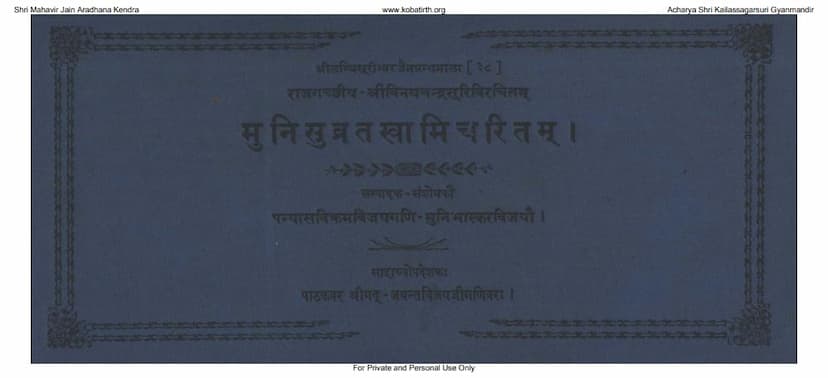Munisuvratswami Charitam
Added to library: September 2, 2025

Summary
Here's a comprehensive summary of the "Munisuvratswami Charitam" based on the provided text:
Title: Munisuvratswami Charitam Authors: Vinaychandrasuri, Vikramvijay, Bhaskarvijay, Jayantvijay Publisher: Labdhisuri Jain Granthmala Published: Vikram Samvat 2013 (1957 CE), first edition.
Overall Purpose and Nature of the Text:
The "Munisuvratswami Charitam" is a Sanskrit poetic work that narrates the life and teachings of the 20th Tirthankara, Shri Munisuvratswami, in the current descending era (Avasarpini). It is presented as a significant contribution to the "Dharmakathanuyog" (narrative theology) within the Jain tradition, which aims to inspire readers through stories of virtuous individuals. The text emphasizes that narrative literature serves as a potent medium to impart religious, ethical, and moral values to all sections of society, allowing them to understand life's purpose and achieve spiritual fulfillment.
Content and Key Themes:
The book meticulously chronicles the life of Munisuvratswami, beginning from his state of right-faith (Samyaktva) in a previous birth. It details his journey through nine significant lives that preceded his birth as a Tirthankara. In each of these lives, the text highlights:
- His Vows and Virtues: The narrative emphasizes his unwavering adherence to vows, his philanthropic nature, his devotion to dharma, and his cultivation of various virtues like patience, forgiveness, humility, non-violence, truthfulness, detachment, and self-control.
- His Noble Deeds and Contributions: The text illustrates how, in each life, he performed acts of great merit and contributed to the well-being of others, laying the groundwork for his future role as a spiritual guide.
- The Tirthankara Life: The book provides a detailed account of his final birth as Munisuvratswami. This includes:
- The Twelve Auspicious Events (Kalyanakas): Celebrations and rituals performed by celestial beings and gods during his birth, initiation, kevala knowledge, and other significant life events.
- The Samavasarana: The description of the divine assembly hall created for his teachings, detailing its structure and the presence of various beings.
- His Teachings: Munisuvratswami's sermons on the four pillars of dharma (Dana - charity, Sheel - conduct, Tapa - penance, and Bhav - contemplation) and other spiritual topics are presented, aiming to inspire righteous conduct.
- The Establishment of the Four-Tiered Congregation (Chaturvidh Sangh): The formation of the monastic order, nuns, laymen, and laywomen under his spiritual guidance.
Literary and Scholarly Aspects:
- Poetic Style: The "Munisuvratswami Charitam" is a work of Sanskrit poetry, characterized by the skillful use of various literary devices and figures of speech (Upama, Anyokti, Anupras, Vakrokti, Virodhabhas, etc.). The authors have aimed to make the narrative engaging and inspiring.
- Commentary and Scholarship: The publication includes editorial work by Pandhyas Vikramvijaygani and Muni Bhaskervijay, with guidance from Pathakavar Shri Jayantvijayji Ganivar. This suggests a scholarly approach to presenting the text.
- Manuscript Basis: The text was compiled and edited using three handwritten manuscripts, with particular emphasis on the ancient manuscript from the Dhelana Upashray in Ahmedabad for textual accuracy and clarification.
- Inclusivity of Jain Dharma: The introductory remarks (Prastavika) contextualize the importance of Katha Anuyog within the fourfold classification of Jain teachings (Dravyanuyog, Ganitanuyog, Charanakarananuyog, and Kathanuyog), drawing parallels with similar traditions in Vedic and Buddhist literature.
- Author's Legacy: The text also provides a biographical sketch of the primary author, Acharya Vinayachandrasuri, placing his active period in the 13th and 14th centuries Vikram Samvat. It mentions his other works and highlights his reputation as a prolific writer and scholar.
Structure of the Narrative (as suggested by the chapter titles):
The provided text seems to cover the following narrative progression:
- First Chapter (Pratham Saraga): Focuses on the initial lives and the life of Meghavahana.
- Second Chapter (Dwitiya Saraga): Continues the past life narratives, including those of Sankash, Abhayankara, and Agadatta, as well as an initial mention of the second rebirth.
- Third Chapter (Tritiya Saraga): Covers the rebirths of Kushal, Abhayankara, and the lineage of Harivansh, leading to the divine birth.
- Fourth Chapter (Chaturtha Saraga): Details the preachings, specifically focusing on the importance of Dana (charity) through the story of Mangalkalash, and the virtue of Sheel (conduct) through the story of Subhadra.
- Fifth Chapter (Panchama Saraga): Continues with stories illustrating the principles of Tapas (penance) through the tale of Ghatkumar and the concept of Sanket (signaling) and Viprit (contrary actions) in the story of Vankachool.
- Sixth Chapter (Shashtha Saraga): Explores themes of Viprit Karma (contrary actions), Vichikitsa (doubt or disbelief in the faith), and the consequences of following false paths, illustrated through the stories of Vankachool, Dharmadev, and the story of Jits hatru and Manatilak.
- Seventh Chapter (Saptama Saraga): Continues with tales like Vankachool's further moral development and the story of Vishnukumar, highlighting the power of dharma and the consequences of actions, and the story of Sukosal.
- Eighth Chapter (Ashtama Saraga): Narrates the story of Skandacharya, and the pivotal event of the earthquake and the subsequent actions of Vishnukumar, leading to a deeper understanding of dharma and the refutation of false beliefs.
- Ninth Chapter (Navama Saraga): Covers various aspects of dharma, including stories of Ghatkumar, Vankachool, Dharmadev, Subhadra, Manatilak, Rishi Datta, and Vishnukumar's role in averting the earthquake, demonstrating the interconnectedness of actions and their consequences, and the importance of right faith.
Significance:
The "Munisuvratswami Charitam" serves as a valuable resource for understanding Jain philosophy, ethics, and the exemplary lives of Tirthankaras. It aims to foster devotion and inspire ethical living among its readers through rich narratives and poetic expression. The text is a testament to the Jain tradition's emphasis on learning through stories and the profound impact of virtuous lives on spiritual progress.